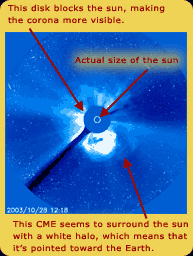



|
Coronal Mass Ejections A coronal mass ejection, or CME, for short, is an ejection of large amounts of matter from the sun’s atmosphere, or corona. One of the most spectacular displays of solar activity, CMEs can fling into space billions of tons of solar material, called plasma, as well as embedded magnetic fields. The ejected material hurdles into space at speeds up to several million miles per hour, creating an interplanetary shock wave. CMEs are thought to arise from large-scale magnetic instabilities. The solar atmosphere is contained by magnetic fields that can suddenly rearrange, releasing an enormous bubble of matter—a coronal mass ejection. CMEs are sometimes (but not always) associated with solar flares . We are able to see CMEs thanks to a special type of telescope called a coronagraph. Ordinarily, the bright light of the sun drowns out most of the detail of the corona. A coronagraph gets around this problem by creating an artificial eclipse. A circular shade in the middle, called the occulting disk, blocks out the bright sun so the corona can be seen. You can spot CMEs on a coronagraph image as a large white tongue, blob, or halo that erupts from the corona. CMEs that are pointed toward earth are called halo events, because the approaching matter seems to surround the sun like a halo. Traveling at an average speed of a million miles per hour, a halo-event CME generally reaches the earth in two to four days, where it may cause a geomagnetic storm. Look for CMEs using live data . Watch a movie of coronagraphs compiled over the last few days . Watch a movie of the spectacular October 2003 event . |
|
|
© Exploratorium

